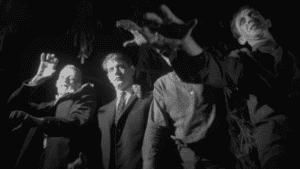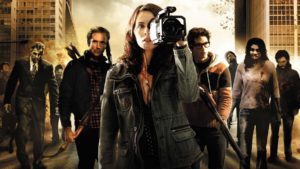I have been waiting with baited breath to finally read the book The Living Dead, which was started by George A. Romero and finished by New York Times bestselling author Daniel Kraus (read our interview with him here). I knew that it had begun as a thought and a few pages by the late filmmaker in the last quarter of a century and was mentioned several times in interviews, but the final product was never finished.
After he passed away in 2017, his widow contacted Kraus, who was known for his collaborations with Guillermo del Toro, The Shape Of Water (2018) and Trollhunters (2015), the former of which was based on the same idea the two created for the eponymous Oscar-winning film while the latter was developed into an Emmy Award-winning Netflix series. He’s also earned himself Bram Stoker Award nominations for his books, Scowler (2012) and Rotters (2013). Now in 2020, he’s finally set his newest tale upon the earth, one that was started with great hope and finished with bloody gore.
The Living Dead summary:
Set in the present day, The Living Dead is an entirely new tale, the story of the zombie plague as George A. Romero wanted to tell it.
It begins with one body.
A pair of medical examiners find themselves battling a dead man who won’t stay dead.
It spreads quickly.
In a Midwestern trailer park, a Black teenage girl and a Muslim immigrant battle newly-risen friends and family. On a US aircraft carrier, living sailors hide from dead ones while a fanatic makes a new religion out of death. At a cable news station, a surviving anchor keeps broadcasting while his undead colleagues try to devour him. In DC, an autistic federal employee charts the outbreak, preserving data for a future that may never come.
Everywhere, people are targeted by both the living and the dead.
We think we know how this story ends.
We. Are. Wrong.

What Works
Let me start this off by saying I received a copy of The Living Dead in May of 2020. Yes, during the Covid-19 pandemic. What better time is there to dive into a story about the world coming to an end than during the corona virus outbreak? Reading about the public’s reaction and ensuing full-scale panic was eerily familiar to what I was seeing on the news and even right outside my own door. While the corona virus didn’t spread as fast as the zombie plague (and the infected weren’t jumping up out of coffins to take a chunk out the necks of the funeral goers), the country—and the world at large—did react in a way that brought to mind every post-apocalyptic story we’ve ever seen, just in slow motion. Unfortunately for the protagonists in The Living Dead, they were not so lucky. From the addition of the very first aberration of John Doe case # 129-46-9875 in the American Model of Lineage and Dimensions, people lost their shit. Cars crashed. Buildings burned. Shotguns blew people in half. The world went to Hell in a hand basket in a matter of hours. In the middle of it all, we meet our protagonists.

We have Greer, a Black high schooler from the Midwest who becomes trapped by the dead in her dilapidated trailer; San Diego Assistant Medical Examiner Luis Acocella and his assistant, Charlene “Charlie” Rutkowski, the first to meet the newly awakened John Doe; talking head Chuck “The Face” Corso, WWN’s beautiful yet thickheaded correspondent, the only one still on the air as the world crashes around him; and Master Boatswain’s Mate Karl Nishimura, the last living helmsman who’s trapped with sailors both living and dead onboard the incapacitated air craft carrier, Olympia. They all have only one thing in common … survive the night and don’t get bitten.
And through it all, keeping careful notes, is Etta Hoffman. Like many introverts during Covid-19, Etta uses the zombie apocalypse to hunker down in an impregnable shelter and attempt to ride it out. Luckily for humanity, she’s great at taking notes. The name, Hoffman, will be familiar to those who study Romero, as the 1951 comic opera, The Tales Of Hoffman, is one of his favorites. That film is an adaption of Jacques Offenbach’s eponymous 1881 play, which in itself was based on three short stories by E.T.A. Hoffman. Anyone who’s seen the film, watched the play, or read the stories will find well-hidden shoutouts to the works sprinkled throughout the book, yet another homage to the late, great filmmaker.

And, of course, there’s the zombies themselves. Kraus manages to give them both purpose and personality, making you feel a bit sorry for them, especially towards the end. With their hive mentality and desire to consume, they work together seamlessly like no human group has done before or since. It’s almost inspiring to watch them come together. And, much like Bub in Day of the Dead, they learn. They yearn. They travel. And, unlike the zombies of yore that reanimated and stopped rotting, these guys are actually affected by their environments, a fact that I love. The zombie virus almost seems to make sense in Kraus’s hands.

Every idea and thought from The Living Dead is taken from George Romero’s own zombie canon. Between his decades of filled notebooks to the movies that made him the horror icon that he is, Romero knew what he wanted to say. And, like the most dedicated biographer, Daniel Kraus listened. He did his homework. He studied the films—even the non-zombie ones—waited with baited breath for boxes of notes and pages written and typed in the filmmaker’s own hand, and scoured the internet for long-lost Romero info. He took everything he found and incorporated it into The Living Dead, even going so far as to rewrite almost 400 pages after getting newly found notes in the mail. There is not another more dedicated soul to George A. Romero than Daniel Kraus, and it shows. The story of the entire zombie apocalypse is told in The Living Dead, complete with zombie hoards, survivor’s guilt, zombified animals, and the consequences of a new “normal” of living in a world with flesh-eaters, right up to the point where society forms again. You don’t need to pause while the credits roll and get up to change the DVD … it’s all here in one bloody package.
You can almost see Romero peeking up over the pages like a bespectacled Killroy. The book has him written all over it. Characters grow up and fall down. going from insensitive and narcissistic to humble and withdrawn. Physical loveliness is eclipsed by the ravages of this new world only to be replaced by inner beauty. Rather than self-combusting in a flaming geyser of one-notedness, these characters adapt, leaving behind stereotypical assumptions to help a new world through its growing pains. Characters you love will die in painful and unfair ways, and villains don’t always meet their justified fates. Everything comes full circle, and there is no happily ever after. But hey, it wouldn’t be George A. Romero if it did.

Pre-order The Living Dead Here
What Doesn’t Work
I love everything about The Living Dead except for one thing. It’s long. Like 700+ pages long. I understand why there’s so much content, since the story is so all-encompassing and broad. But I did think that things could have been whittled down a little bit. A more streamlined approach would have lightened the load of this book—literally—while helping to keep the jack rabbit pace of the story in full swing. Some details and tangents can be sacrificed for the the greater good. Of course, then I would probably be calling for the uncut version, just to see what I missed. But I digress.

Final Thoughts
The Living Dead is the ultimate zombie novel. Every aspect is hit upon. Like any great story, you’re left wanting more. By hook or by crook, Danial Kraus (don’t forget to check out our interview with him here) has managed to tap into the mind of the Godfather of All Zombies and bring his story to life … or, unlife. When you finally turn that last page, you can’t help but wonder where it all goes next. And, like the ultimate zombie, Romero forever lives on in The Living Dead.
 PopHorror Let's Get Scared
PopHorror Let's Get Scared



